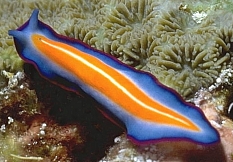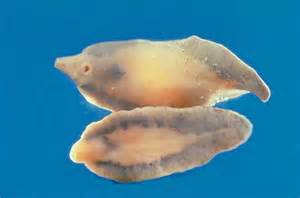When most hear the word worm unpleasant things come to mind. “Gross”, “dirty”, “decaying”, “disease”, “rotten”, are a few. And then there is the whole parasite thing. But then there are those who like them. Gardeners, kids, and fishermen find earthworms in particular pretty cool. They are not the typical creature we look for on a hike, or search for on a TV documentary, and they are certain not at the top of creatures you would be looking for while exploring a seagrass bed – but they are there.
According to the 4th Edition of Robert Barnes’s Invertebrate Zoology (1980) there are at least 11 phyla of worms, and he mentions no fewer than six classes. It is an extremely diverse group of creatures, and many are the bridge between the simple animals and the more complex. In this article we will focus on four phyla of the more common worms, or least the ones most commonly known.
These phyla are divided by body shape and internal complexity. The simplest are the flatworms (flukes and tapeworms), the more complex are the annelids (earthworms and leeches). The vast majority of these animals are very small (less than one centimeter) and not seen by the casual snorkeler. Some of the nemerteans (a phyla of flatworm) and the segmented polychaetes (related to earthworms) are quitter large and are easily seen by us.
The polychaetes may be the most familiar to us. These are segmented worms in the phylum Annelida. They are segmented like their cousins the earthworm but differ in that (a) each segment has a small leg-like structure (parapodia) and (b) they like marine conditions.

They resemble centipedes crawling in and amongst the seagrass blades and are often found within seashells we pick up and explore. They are basically harmless, and many species are the “garbage feeders” doing an excellent job keeping the system clean. We often see their “volcano” like burrows in the sandy areas within a seagrass meadows and many species produce glob-like gelatinous egg sacs that seagrass explorers confuse with jellyfish. There are also those that produce tubes. Some of these tubes are paper-like with bits of shell and other debris embedded in them. They produce these using mucous from their bodies to cement them together, place the tube within the sediment in a vertical position, and then live in them. Other tubeworms will produce their tubes out of shell material (calcium carbonate) forming snake-like structures on the surface of shells and discarded beer cans. And then there are a few called bristle worms. These are large and crawl across the surface of the substrate but have thin spines that extend off their bodies like cactus. Many of these do have venom and can be quite painful.
Polychaetes are the most advanced of the marine worms in the seagrass beds. Possessing a brain that is connected to sensory organs that can detect light and chemicals in the water, they can both find prey, and avoid predators. Prey varies between species. Most polychaetes can invert their pharynx (rather quickly) to grab prey using tooth like jaws. The carnivorous ones feed on small invertebrates (including other polychaetes). Others will use these jaws to scrap algae from shells and grass blades and are scavengers. Most reproduce sexually where there are both males and females and they possess a complete digestive tract (including a mouth and an anus) – as you will see… not worms do. In 1980 there were about 5300 species of them worldwide.
Nemertean worms are another large marine worm, but one few people have seen. This is because they are more nocturnal by habit. They are not segmented but rather are flat and gelatinous. They possess a proboscis that can be “launched” by the worm, that has a stylet (spear) at the tip – like a pole-spear gun. They use this to hunt invertebrates and find them by using their sense of smell. They also reproduce sexually, and there are separate males and females, but many will fragment into smaller worms when irritated. There are two classes and four orders of these worms worldwide.
Most of the remaining worms are either so tiny you will not find them or are endoparasites living within some vertebrate or invertebrate host within the seagrass community. The more famous group are the flatworms. These include the parasitic flukes and tapeworms. However, there is a class of free-swimming flatworms that crawl (or swim) around the “seagrass forest”.
The swimming ones are known as tubellarians. Most are clear or opaque, but in the coral reef community some are very colorful. Flatworms are the more basic members of the worm group. They lack a complete digestive system and must both eat and expel waste through the same opening (the mouth). Some tubellarians feed on small invertebrates which they capture and engulf without using teeth. Others feed on dead and decaying creatures, again – cleaning the environment. There are some that live commensally with mollusk and crustaceans. There is one that is rather large and can be seen on the gills of horseshoe crabs. They do have a simple brain and sense the world by detecting light, a sense of touch, and smell. In 1980 they reported about 3000 species worldwide.

The parasitic flatworms include the famous flukes and tapeworms. These live within the bodies of their hosts feeding on mucous, cells, tissue, and blood (yep – here is the “gross” “disgusting” thoughts we mentioned at the beginning). They possess tough skin to protect them from the digestive enzymes of their host. Most reproduce sexually but are hermaphroditic (each worm being able to produce both sperm and egg). Most require secondary hosts to complete their life cycle. For example, they may live in the gut of a spotted seatrout but will need to complete their larval stage in the gut of a mollusk. So, the eggs are released with the feces of the trout, the larva find a mollusk and enter, develop, and then expelled again via feces to once again find a trout. It’s a wonder they can do this – but they do.

The tapeworms cycle differs in that their head is round and has a series of hooks they use to embed into the intestinal tract of their host. The rest of their body is flat and segmented (each segment called a proglottid). These proglottids are released into the environment to find another host.
You may now be afraid of becoming infested with parasitic worms if snorkeling in seagrass beds. Fear not… these animals are VERY specific about the host they can survive with – and you are not one of them. Most seagrass explorers do not think of worms when they visit this community, and probably will not see any, but they are there and play an important role in keeping the system healthy.
- St. Joe Red Tide Claiming Terrapins - December 15, 2025
- The 2025 Snake Watch Report for the Pensacola Bay Area - December 15, 2025
- Rattlesnakes on Our Barrier Islands; Part 2 – Prey Selection - December 15, 2025
